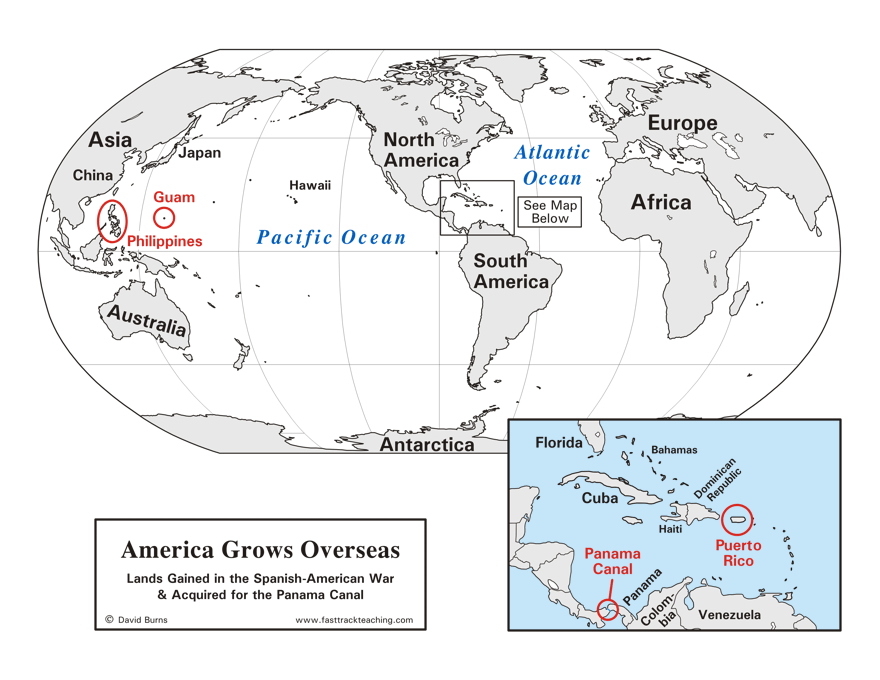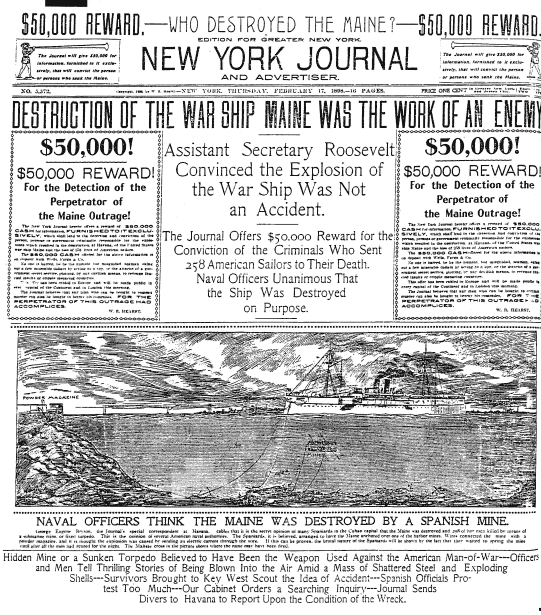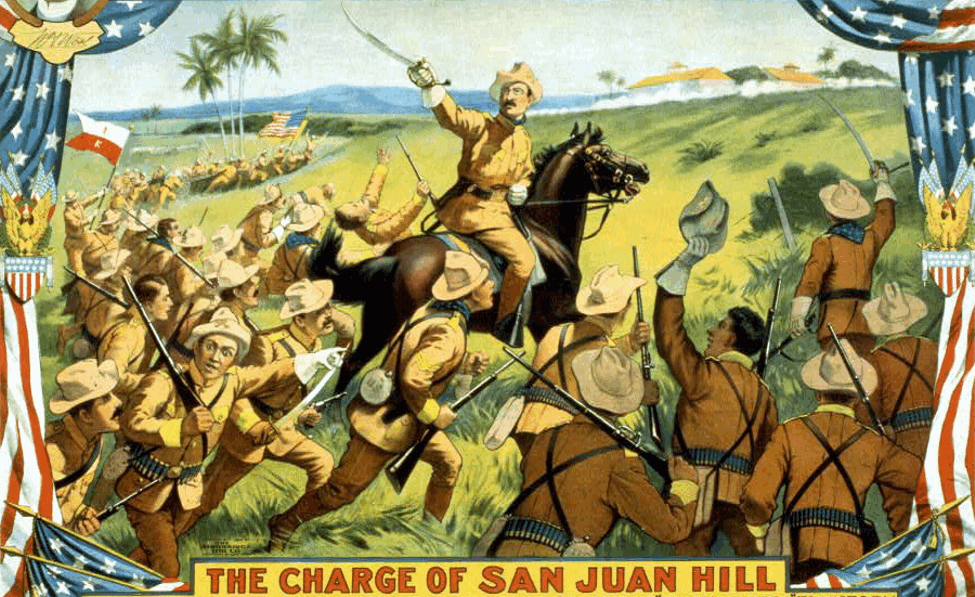
| The
Spanish-American War Frameworks for America's Past |
|
|
When was the
Spanish-American
War?
The Spanish-American War was in 1898. America decided to help the Cuban people, who were fighting to win independence for their country from Spain. Cuba is about 90 miles south of Florida. Take a moment to find it on the map. Also, notice the location of the Philippines, Guam, and Puerto Rico. |

|
Cubans
were rising up for their freedom
The photograph shows some of the Cubans who were already fighting for independence from Spain around 1896. Notice the flag they carry. It was a new flag that represented the hopes of all Cubans who wanted to be free of Spanish rulers. |
The
Spanish response was very
harsh
Spanish rulers in Cuba were harsh in their response to the rebellion. For example, the Spanish leaders forced many Cubans in the countryside to move to camps under the control of Spanish soldiers. Many of these people died because the camps were not supplied with enough food. The photo from 1898 shows sick and hungry Cubans being held at a camp. Americans grew more and more concerned as they read stories in newspapers about what was going on in Cuba. |
|
Americans
had
business interests in Cuba
Besides the bad situation of the Cuban people, Americans were also concerned about what might happen to American business interests in Cuba. Some of the island's sugar cane plantations and sugar mills, for example, were owned by American companies. The situation in Cuba was not good for business. The photo shows Cuban workers on a sugar plantation harvesting sugar cane. They are wearing long sleeves even in the hot weather, because the leaves of the sugar cane plant are so sharp they easily cut bare skin. |
|
A
sugar mill in Cuba
The photo below shows a large sugar mill in Cuba. At the mill the stalks of the sugar cane plants are crushed to squeeze out the sap, which contains sugar. The sap is heated to evaporate the water, leaving solid pieces of sugar. The sugar could then be sold to buyers in many other countries. |
|
The
USS
Maine arrives in Cuba
American leaders decided to send the battle ship USS Maine on a friendly visit to Cuba in January of 1898. It was intended as a show of concern for Americans and American businesses on the island. The photo shows the ship entering Havana harbor. Havana is the capital city of Cuba. At that same time, top Spanish and the U.S. leaders were trying hard to solve the Cuban issue without war, which both nations wanted to avoid. |
|
The USS Maine exploded just weeks later
The USS Maine exploded in February, 1898, and sank in the shallow water of the Havana harbor. Over 250 sailors were killed. The explosion may have been caused by an accident on board. Spanish officials in Cuba denied any involvement. Many Americans, however, believed that the Spanish were to blame, one way or another. The photo shows the top part of the ship sticking out of the water where it sank. |
|
Yellow journalism fanned the flames The big New York City newspapers played up the story of the explosion of the USS Maine. Newspapers at that time competed on the streets for readers. Large, attention grabbing headlines helped boost sales. This style of sensationalistic headlines and reporting was called yellow journalism. This image shows the front page of the New York Journal after the explosion. The cause of the explosion was unknown. Many newspapers, however, left readers with the impression that Spain was probably to blame. Public opinion in America began demanding action, and the battle cry became "Remember the Maine!" |
 |
|
The Spanish-American War began
Spain and America declared war on each other in the spring of 1898. The first action came in the Philippines, however, not in Cuba. At that time, the Philippine Islands, like Cuba, were controlled by Spain. American ships attacked Spanish navy ships located in the Philippines, and quickly destroyed them. |

|
Theodore
Roosevelt and the Rough Riders
became famous in the fighting The fighting in Cuba began in the summer and was over by the end of August. The drawing here shows Theodore Roosevelt leading his Rough Riders in one of the battles. Roosevelt's volunteer regiment did not actually play a decisive role in the U.S. victory in Cuba. Images like this one, however, left the impression that Roosevelt was a bold and talented leader. He returned to the U.S. as a war hero, and only a few years later, he was elected vice-president. Not long after that, he became president of the U.S. |

|
The
results of the Spanish-American War
With the war over, peace talks were held between Spain and the U.S. A treaty was signed by the end of the year. Here is a summary of the outcome: 1. Cuba became an independent country. The U.S. helped the country set up a new government. 2. The peace treaty with Spain gave the U.S. control of the Philippines, Guam, and Puerto Rico. Those had been Spanish territories, but were transferred to the U.S. 3. With the victory over Spain, and control of territories around the world, the United States was now seen as a world power. |

|
Copyright Notice
Copyright 2009, 2017 by David Burns. All rights reserved. As a guide to the Virginia Standards of Learning, some pages necessarily include phrases or sentences from that document, which is available online from the Virginia Department of Education. The author's copyright extends to the original text and graphics, unique design and layout, and related material. |